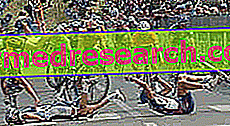first part
In a stage race, getting involved in a fall has heavier consequences than running online. Even slight bruises are in fact quite annoying and could make it very difficult to find the sleeping position at night. Pain and incomplete recovery make the task that the cyclist has to face in the following days tougher. In cases like these the "character" of the athlete must come out. The ability to "grit your teeth", when the doctor has excluded complications, should not be limited to cases where you are at the top of a ranking, but also include all other cases (possibility of partial results, teamwork, etc. ).

Falling in groups can give rise to significant results both due to the unpredictability with which it manifests itself, and due to the additional damage caused by the impact with other riders and their bicycles.
Serious consequences can derive from falls during a descent or during sprints, or due to errors in assessment or abuses suffered.
The most affected muscle groups in the field of cycling traumatology are the ischiocrural (flexor muscles of the leg) which can undergo contractures and insertional inflammations (piriformis syndrome) if the saddle is excessively high. Conversely, if the saddle is too low, the extensor musculature of the leg and the ileopsoas muscle (deep in the pelvis) may show alterations.
The prevention of trauma in cycling is a task that also and above all the competition organizers, who must view the routes to ensure their safety, by setting up a network of functional relief in the event of falls to the ground. The cyclist on his part must take care of the perfect efficiency of the mechanical means.
Although it may be cumbersome and annoying, the shell-shaped helmet in lightweight plastic is the only effective means of protection for the garment.
The abrasions (superficial lesions of the skin or mucosa caused by traumas that smear the surface of the body, without spilling blood) and the bruises are the most frequent occurrence in the trauma of runners. These occurrences are characterized by the more or less significant loss of blood and the swelling of the affected area. The complications are represented by infections, if adequate cleaning and medication are not practiced.
Muscle hematoma
Causes: injury to muscle fibers and related blood vessels.
Clinical manifestations: pain and limitation of contractile efficiency.
Treatment: application of ice and rest of the affected limb; the blood flow is reabsorbed within a few days. Muscle manipulations are not necessary, which could even complicate healing.
Lacerated and contused wounds
They affect the subcutaneous tissue and can involve the muscles. They require a prompt dressing, with suturing of the affected tissues.
Injuries to the genital and abdominal organs
They are not very frequent, but may result in an acute traumatic abdomen that requires prompt surgical treatment. In most cases, lesions to the genital and abdominal organs are due to the impact of the handlebar (brake levers) that follows a single or collective fall.
Head injuries
Superficial scalp wounds are preventable if the protective helmet is used; Cranial traumas of a certain gravity are the consequence of the violent impact of the cyclist's head on the road surface, or against obstacles such as sidewalks, fences, poles.
The injured runner must be rescued paying particular attention to the mobilization of the delicate areas of the cervical spine. The athlete must then be sent to an equipped health center for an accurate diagnostic evaluation. The neurological observation of the injured person should continue for a few days, given the temporal sequence in which some cranial hematomas occur.
INJURIES IN CHARGE OF BONES AND JOINTS
The districts most affected are the upper limbs and shoulders, due to the runner's characteristic fall pattern. Upper limb fractures involve the hand, wrist, forearm and elbow bones.
The fracture of the radial head is one of the most frequent injuries of the traumatized elbow of the sportsman. It is characterized by the following factors: - its frequent diagnostic disavowal, in non-decomposed forms or, conversely, in important traumas where it can go unnoticed; - its possible association with other lesions, especially ligaments; - the constant tendency to early stiffening of the elbow in the event of immobilization.
Most of the time, clinically, we are faced with the story of a fall, with an elbow in hypertension, which causes a compression in the valgus of the elbow. The patient complains of direct pain on the outer surface of the elbow, sometimes associated with a crunching impression.
Shoulder fractures mainly affect the clavicle, while dislocations are more frequent in the acromioclavicular joint.
The acromioclavicular joint is constituted by the external extremity of the clavicle, whose articular surface rests on the acromion. This articulation, completed for about a third of the cases by a meniscus, is stabilized by a capsuloligamentous and muscular system that can be damaged in the course of sports practice.
However, the knee is the most stressed articulation in pedaling and is the site of clinical problems.
Femoro-patellar pathologies
One of the first diagnoses to think about in a sportsman who complains of spontaneous knee pain is that of a suffering of the femoro-patellar joint. In fact, certain sports, such as cycling, rowing or weight lifting, can highlight a dysfunction of this articulation which, in a sedentary patient, will manifest itself much later and sometimes never.
In the past, patellar fractures and knee ligament distractions were described with relative frequency. The latter occurred in an attempt to free the foot from the toe-rest pedal following a fall. Current pedals with quick release limit the onset of such traumas. The behavior to be taken in the presence of a runner with suspected fracture signs is to avoid movement from the site concerned.
Of all the knee tendinopathies in the sportsman, the most frequent is that involving the extensor apparatus, due to the fact that the apparatus is subjected to important stresses.
The sports involved are those that involve an important work of the quadriceps, such as cycling or rowing, or sports that require thrusting movements such as the volleyball, figure skating or jumping (long, high and triple).
The extensor apparatus works in conditions that interfere with the patellar dynamics and each anomaly of one is reflected on the other. Thus in every tendinous suffering of the extensor apparatus we will have to think of a patellar instability of which the tendinopathy can only be the consequence.
The microtraumas are established with slow temporal progression, following the continuous loads to which some districts of the locomotor system are subjected. The presence of alterations in the alignment of the bone segments of the lower limbs and / or an incorrect position in the saddle are the predisposing factors.
The microtraumatic pathology in the cyclist mainly affects the knee, particularly in the tendon and cartilaginous structures.
The tendonitis of the patellar and quadriceps occur due to the increase in the flexor play of the knee joint due to a saddle that is too low, or the position in the tip of the saddle maintained for a long time, or by the use of cranks that are too long. Even the choice of very long ratios, especially at the beginning of the preparation, overloads the muscle-tendon extensor apparatus of the knee.
The knee joint may exhibit alignment changes due to anatomical reasons. In the runner with valgean knees, the outer compartment is most stressed; in the case of knees go to the inner compartment. These changes can result in knee osteoarthritis and patellar tendonitis. As a preventive measure, selective strengthening of the quadriceps is appropriate.
Alterations in the alignment of the bone segments of the foot
Such alterations cause consequences at the knee level. Hyperpronation of the foot tends to produce an unnatural abduction of the knee joint. In this situation, the contraction of the quadriceps in the phase of pushing the pedal tends to move the patella outwards. This creates frictions between the lower surface of the patella and the femoral condyles which, with the passage of time, can give rise to chondromalacia patella . The prevention of this pathology, which manifests itself with pain and intra-articular effusion, consists in strengthening the supporting muscles of the foot and in using special soles, inserted inside the shoe, in order to rebalance the load supported by the foot.
Inflammation of the Achilles tendon
In the cyclist, the inflammation of the Achilles tendon is much less frequent than in endurance sports with overload on the ground (running on foot). The predisposing factors of this tendinitis are the low saddle, the excessive dorsiflexion of the ankle during the traction phase of the pedal stroke and the hindfoot valgus and launch.
The main symptoms are: pain and stiffness along the back of the tendon, in particular towards the heel, limited flexibility of the ankle, heat and redness in the painful area, a nodule (formed by scar tissue) that can be touched with the fingers along the tendon.
Treatment benefits from athletic rest (the first recovery phase includes only physical activities that do not load the foot, such as swimming) and physical therapies.
Metatarsalgia
It is a painful affection of the metatarsal heads, due to the excessive pressure exerted by the foot on the pedal and to its incorrect position. The treatment consists in performing a cycle of physical therapies and applying a plantar that discharges the metatarsal heads.
Cervicalgia and low back pain
The assumption of aerodynamic positions on bicycles and the marked lowering of the handlebars cause hyperextension of the cervical tract and hyperflexion of the lumbar-dorsal tract. This can lead to the appearance of painful contractions at the dorsal level.
Prevention of low back pain and neck pain is achieved by varying the position of the saddle, changing the height of the handlebar and avoiding exerting strong traction with the upper limbs. The treatment aims to relax the contracted muscles with the aid of massage, physical therapies ( ultrasound and infrared ) and other medical therapies.
Edited by: Lorenzo Boscariol



